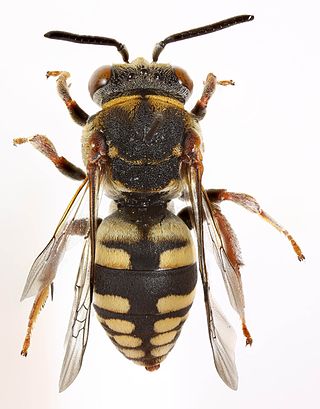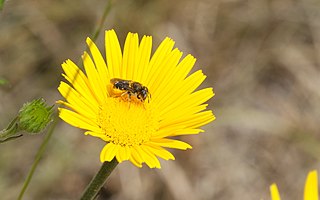
Yellowjacket or yellow jacket is the common name in North America for predatory social wasps of the genera Vespula and Dolichovespula. Members of these genera are known simply as "wasps" in other English-speaking countries. Most of these are black and yellow like the eastern yellowjacket and the aerial yellowjacket ; some are black and white like the bald-faced hornet. Others may have the abdomen background color red instead of black. They can be identified by their distinctive markings, their occurrence only in colonies, and a characteristic, rapid, side-to-side flight pattern prior to landing. All females are capable of stinging. Yellowjackets are important predators of pest insects.

Cirsium vulgare, the spear thistle, bull thistle, or common thistle, is a species of the Asteraceae genus Cirsium, native throughout most of Europe, Western Asia, and northwestern Africa. It is also naturalised in North America, Africa, and Australia and is an invasive weed in some areas. It is the national flower of Scotland.

Hylaeus is a large and diverse cosmopolitan genus within the bee family Colletidae. This genus is also known as the yellow-faced bees or masked bees. This genus is the only truly globally distributed colletid, occurring on all continents except Antarctica.

Osmia cornuta, the European orchard bee, is a species of bee in the genus Osmia.
Lipara is a genus of flies in the family Chloropidae. Among the Palearctic species, a specific community of bees and wasps make their nests in the galls of chloropid flies. Most frequently, they use the galls induced by Lipara lucens on common reed stems. Some of these aculeate hymenopteran species, such as the digger wasp Pemphredon fabricii (Crabronidae) or the solitary bee Hylaeus pectoralis (Colletidae) are specialized for nesting in galls induced by Lipara spp. more than a year ago.

Megachile maritima, common name coast leaf-cutter, is a species of leaf-cutter bees in the family Megachilidae. It was described by William Kirby in 1802.

Epeolus cruciger, the red-thighed epeolus, is a species of cuckoo bee from the family Apidae. It is endemic to Europe, where its main host is the common colletes, although other species of Colletes mining bees have been recorded as hosts.

Cerceris rybyensis, the ornate tailed digger wasp, is a Palearctic species of solitary wasp from the family Crabronidae which specialised in hunting small to medium-sized mining bees. It is the type species of the genus Cerceris and was named as Sphex rybyensis by Carl Linnaeus in 1771.

Hylaeus agilis is a bee species in the family Colletidae. It is endemic to New Zealand. This species is found throughout the country and visits the flowers of a wide variety of plant species, both native and introduced.

Andrena bicolor, or Gwynne's mining bee, is a common and widespread Western Palearctic mining bee which is found over most of Europe as well as North Africa and the Middle East and which reaches eastwards into Siberia.

Colletes similis is a species of plasterer bee belonging to the family Colletidae, subfamily Colletinae.

Hylaeus confusus is a Palearctic species of solitary bee. It is known to nest in reed stalk galls.

Hylaeus relegatus is a bee species in the family Colletidae. It is endemic to New Zealand and was first described by Frederick Smith. It is the largest and most common species of this genus in that country. H. relegatus can be found throughout the three main islands of New Zealand and visits the flowers of a wide variety of plant species, both native and introduced. Although widespread, this species is not abundant at any one particular location. It has been hypothesised that human made nest sites can be used to increase its numbers.

Anthophora bimaculata is a species of bees.

Osmia spinulosa, also known as the spined mason bee, is a species of bees within the genus Osmia.

Trachusa byssina is a species of bees within the genus Trachusa.

Hylaeus nubilosus is a species of insect within the genus Hylaeus. It is commonly referred to as the cloudy masked bee.
















